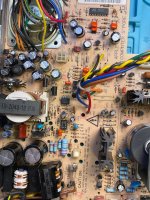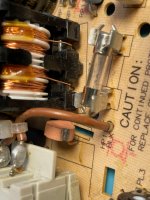I'm trying to revive a dead Mac Classic - the analog board was in pretty sad shape with the existing capacitors having leaked all over. I scrubbed it clean and recapped it - put it back in, turned it on and nothing happened. I noticed the fuse was blown, so I put in another 3A 250v fuse, flipped the switch and got a beauty of an arc near the fuse and RP2.
There's now a lovely scorch mark on RP2 (what is that anyway??) and another blown fuse.
Even though the back of the board looks bad, I checked continuity and it doesnt seem like there's any open solder joints or shorts between major circuit runs. Any ideas what else to look at?
Is it 'safe' to energize the analog board without it being connected to the monitor and motherboard (assuming I've got the flyback lead taped down and far away from anything conductive)? I'd love to be able to test the thing without actually connecting it up and frying more parts.




There's now a lovely scorch mark on RP2 (what is that anyway??) and another blown fuse.
Even though the back of the board looks bad, I checked continuity and it doesnt seem like there's any open solder joints or shorts between major circuit runs. Any ideas what else to look at?
Is it 'safe' to energize the analog board without it being connected to the monitor and motherboard (assuming I've got the flyback lead taped down and far away from anything conductive)? I'd love to be able to test the thing without actually connecting it up and frying more parts.




